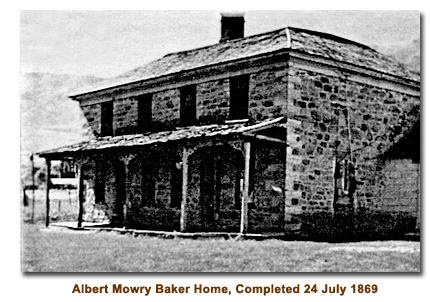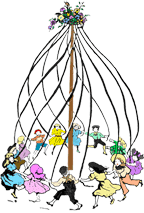Jane Maria Curtis Baker
In the little village of Holbeach, Lincolnshire, in the southern part of England, on November 14th, 1835, Jane Maria Curtis was born. She was the only child of Sarah and Charles Henry Curtis. She was reared in moderate circumstances, received a fairly good education in this same locality. In those days the principal thing taught the girls in school, was the art of sewing. They must be taught how to use a needle, and use it well. Maria loved to sew, and this knowledge has been a great help all her life, especially during the pioneering days in this country. When Maria was eight or nine years old, Mormon Elders frequently visited the village. Her parents became interested and were finally converted by Elder Eyre. When Maria was eleven years old, she, (with five other girls) was baptized by a local Elder named Curedan.
Soon after the conversion of Brother and Sister Curtis, a feeling of going to Zion came over them, but for some time they were kept on account of means. Finally an opportunity came, an elderly woman, Miss Derby, (seventy-two years old) also a convert, was anxious to come to America. It seems she had no relatives, no one to come with her. She was a dear friend of Mrs. Curtis and offered to pay her expenses if she would go with her and care for her. Mrs. Curtis told her she would be glad to do so, but she had her daughter Maria— whom she could not leave. Miss Derby felt she could not pay the fare of both, but after some consideration, agreed to take the daughter also. Mr. Curtis was anxious to come with them, but at this time he was Presiding Elder of the district around which he lived, and was requested to remain another year. A company of Saints was about to leave. Brother Appleton Harmon, a returning missionary, was in charge of the company of six hundred Saints, and Maria, her mother and dear friend Miss Derby came with them. They left Liverpool in the spring (1853), in a sailing vessel, (not the beautiful and convenient steamer of today) but a rough sailing vessel [Golconda] with masts. They were eight weeks and two days on the water. When several days out at sea, a terrific storm caught them and broke three of the large masts, which took three weeks to repair. During this time, they were tossed here and there on the water, and had many unpleasant experiences.
They finally landed at St. Louis. Here they remained for a month, then went by steamer up the Mississippi River to Keokuk, where they obtained outfits (oxen and wagons) to start on their journey to the Rocky Mountains. They were ordered to leave all trunks and boxes— and to roll all their possessions into bundles, on account of weight, also that they might be handled easier. Maria had a sort of stand-in with Brother Harmon, who was still Captain of the company and he permitted her to bring her box or chest, it was used for a food box. This chest was dear to Maria, as it was the last gift from her English sweetheart. They were three months making this long journey. Many times Maria rode the Captains spirited horse, it being the only horse in the company. They reached Salt Lake City in September 1853. The first year after their arrival, Sister Curtis and her daughter worked for different people— taking for pay, anything they felt they could spare. In the fall of 1854, Simon Baker, having moved his family into town for the winter, secured the services of Mrs. Curtis and her daughter Maria, to assist in the dairy work on the ranch. While they were there they received word of the death of Brother Curtis in England. This was a great shock and sorrow to his wife and daughter. During their stay at the Baker ranch was where Maria first met her future husband Albert Mowry Baker, son of Simon Baker. In a few months an attachment grew between Mr. Baker and Miss Curtis, which resulted in their marriage on Christmas night, December 25th, 1854.
They were married by Horace S. Eldredge in the Seventies Hall in Salt Lake City. They lived on the Baker ranch during 1855-1856. The following spring with his father and others they went as colonists to Carson Valley, Nevada. Leaving his father at this place, Mr. Baker and his wife took an ox team and some stock and moved to Eagle Valley, where they located on a one hundred and sixty acre ranch. They stayed here just a short time. In the spring of 1857 they moved to Warsaw Valley where they started another home. In this locality was a tribe of Indians and one of the squaws often came and washed for Mrs. Baker. This squaw had a very bright little boy seven or eight years old who Mr. And Mrs. Baker grew quite fond of. They finally persuaded the mother to let them have the boy— which she seemed quite willing to do. The bargain was settled by giving the father of the boy a rifle. He said he did not wish to sell his boy, but wanted something to remember him by. This little Indian boy they brought to Salt Lake City with them when they returned in 1857. All the Nevada Saints being called home on the account of the approaching of the Johnston Army to Utah. There was considerable excitement at this time regarding the attitude of the United States government toward the people of Utah. Many of the people moved south. In May 1858, Mr. Baker with his own outfit started for Iron County, southern Utah— his wife Maria driving the team while he and Pete, (the Indian boy) followed with the stock. On this trip, when near Beaver Creek, they were met by a small band of Indian squaws and papooses, and on reaching the crossing, there were lined up on either side of the road about twenty Indian braves, with war paint on and guns ready for action. Mr. Baker, grasping the situation, knowing it was useless to run, told that brave little woman, Maria, to drive on and pay no attention to the Indians. So she drove the ox team through this double line of savages, while her husband, having a hard time to keep the Indian boy from running away, succeeded in driving the stock across the stream. The Indians, when they saw this bravery shown, changed their minds and became friendly, saying, “Heep Man! Ka Squaw!” They remained in Iron County until fall, until things quieted down in Salt Lake, when they again moved back.
In 1860, Maria with her husband and two brothers, Amenzo and George, moved to Cache Valley for the purpose of locating new homes. They located on Gardner Creek, a small stream between Mendon and Wellsville, where some planting was done that season. But finally they moved into Mendon on account of trouble with the Indians and lived in a dugout until a house could be built in the Mendon Fort. In 1864 their log house was moved from the fort onto a lot in the Mendon town site, and before winter they were comfortably located in the new house. They were in better circumstances for home comforts that they had been at any time during their married life, having the best log house, and owning one of the three only stoves in town. During that winter, Sister Maria entertained General Patrick E. Conner and Major McGary, who with a detachment of U.S. Soldiers were on their way to subdue the Indians on Bear River. April 11th, 1865, Mr. Baker married Edna Jane Coon, daughter of Abraham and Elizabeth (Wilson) Coon at Salt Lake City. She was born September 30th, 1848 in Pottawattamie County, Iowa. At this particular time it was the belief of the Mormon people, that those men who were worthy, had the right to marry more than one wife, and that they were justified by the laws of the land as well as the laws of God. This was the sincere belief of Mr. and Mrs. Baker. In 1866 they commenced the erection of an eight room, two-story rock house. A great undertaking in those days. Many of their friends and neighbors said that the house would bankrupt them: nails were one dollar per pound, eight by ten window glass seventy-five cents each and other building materials in proportion. But by perseverance and determination the house was completed in their years, the family moving in on July 24th, 1869. This house for a number of years was the village hotel.
The abandoned log house was for many years used for the Mendon Co-op Store. From this time on, she lived in and around Mendon, trying to live her religion, and to help humanity. She has done a great deal of charity work, and has spent many long hours among the sick. For eighteen years she was counselor to Elizabeth Willie in the Mendon Ward Relief Society, and was president of the same for twenty-two years, making forty years of service. In the fall of 1909, a great sorrow came into her life through the death of her dear husband. He passed peacefully away after a short illness on the 3rd day of September 1909. After this Aunt Maria and Aunt Jane as they were familiarly called by their many friends, lived as they had always done— congenially and comfortably in the old home. Aunt Maria had never been blessed with a family, but Aunt Jane was the mother of eight children, who loved and cared for Auntie as they did their own good mother. It was often said of these children that they were truly fortunate— that they had two mothers. September 1st, 1915 another sorrow came to the family— the death of their mother, Edna Jane, whose useful and unselfish life had endeared her to all. At present Aunt Maria is at the old home, being tenderly cared for by members of the family. She is eighty-three years old, enjoying fairly good health, is truly thankful that she is here. May her life be an inspiration to others to do the right. It can truly be said of Jane Maria Curtis Baker, that she has made many “foot-prints on the sands of time,” that will live forever.1
![]()
![]()
1. Jane Maria Curtis Baker, Sarah Elizabeth Baker, 20 September 1918, unpublished manuscript.
